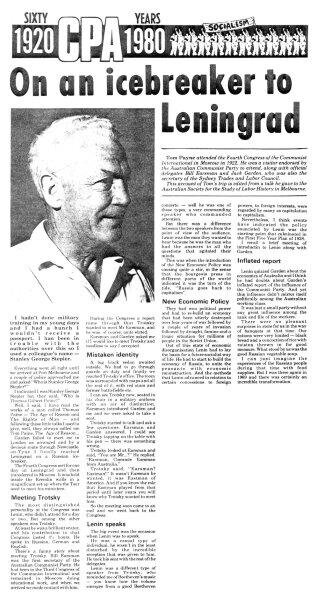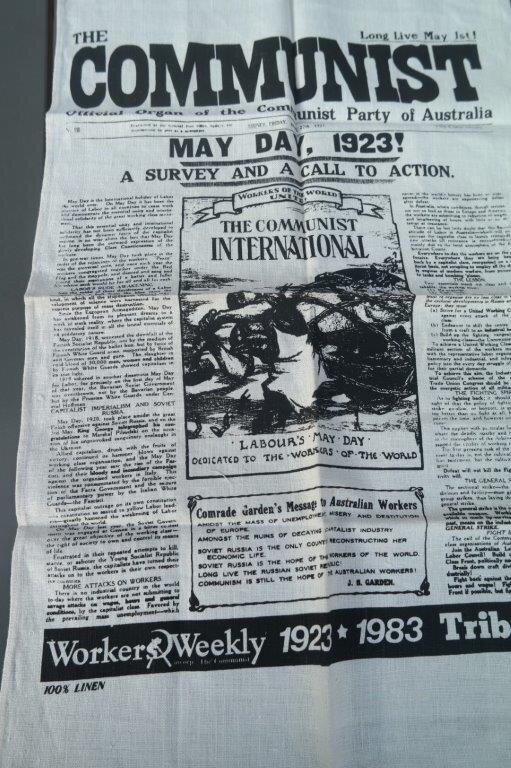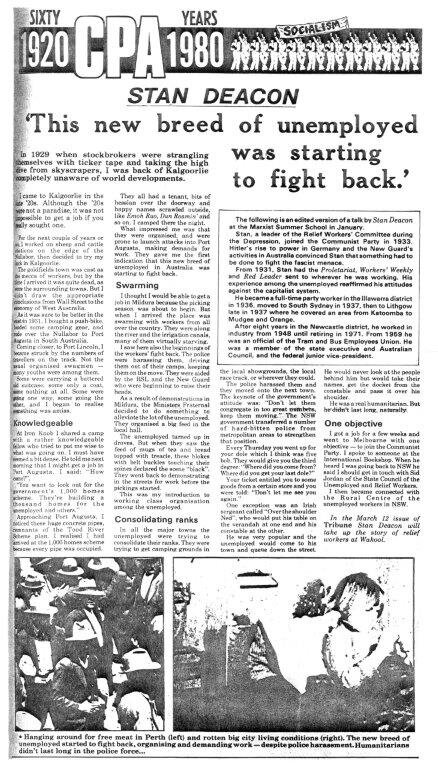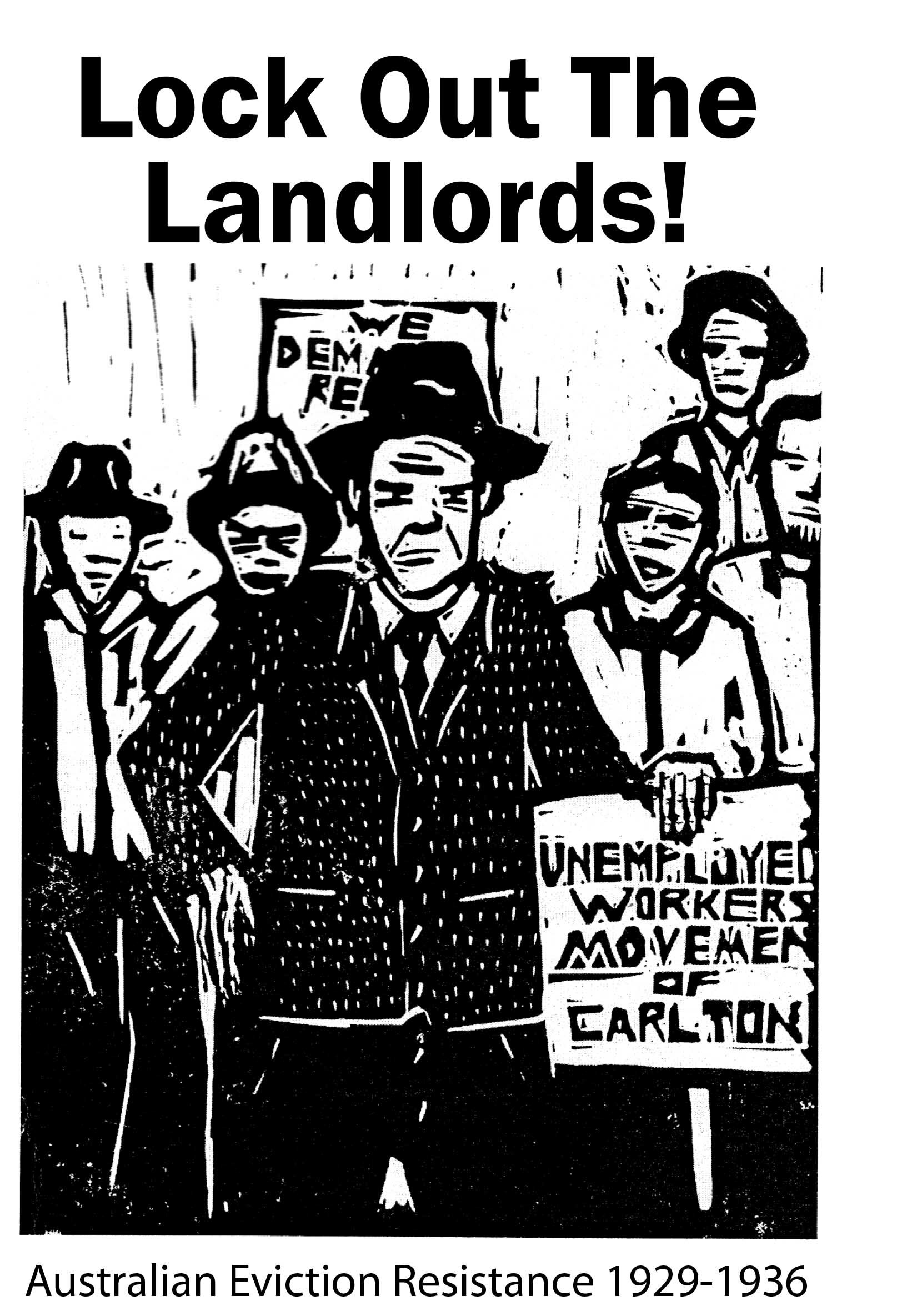
The party was started with few resources, with few big names and with people who came from different traditions and ways of operating.
There were people from a socialist or a social democrat position and some from the Industrial Workers of the World or ‘wobblies’ and they met in the working class area of Sydney.
1920s
A conference in this building on October 30, 1920 decided to form the Communist Party of Australia
395 Sussex St Sydney

Some of the first members of the CPA
Jock Garden unionist, Katherine Susannah Prichard author, Christian Jollie Smith socialist lawyer,
Tom Walsh trade unionist and journalist, Adela Pankhurst suffragette and political organiser.

Christian Jollie Smith

Tom Walsh

Adela Pankhurst

Jock Garden

Katherine Susannah Prichard

The Party's first task was to unite despite several streams of political thought and action.

Guido Baracchi an early member of the Party describes the event and persons involved in the foundation.

Tom Payne met Lenin when he went to Moscow for a congress.

An early edition of one of the Party's papers. The article deals with the difficult issue of relations between the ALP and the CPA. The ALP rejected revolutionary politics.

May Day 1923 publication. "May Day is the international holiday of labor the world over. On May Day it has been the practice of labor in all countries to cease work and demonstrate the essential unity and international solidarity of the great working class movement."

Broken Hill November 7, 1928 a march commemorating the anniversary of the Bolshevik Revolution
The photo of Payne and Earsman meeting other delegates to the Pan Pacific conference was in Shanghai in December, 1927, instead of Sydney, as the Nationalist Bruce Government denied travel visas to foreign delegates.

1930s
The Depression
Struggles against evictions
Campaign against the war in Abyssinia (Ethiopia) Against Fascism and War
Spanish Civil War
Japanese Aggression in Manchuria
Build up to the war and Ribbentrop Pact
Phony war period - War starts in 1939

The Depression

The Dole Queque 1930

The unemployed began to fight back

The fight against evictions

The most famous and vicious anti-eviction fight took place at Tighes Hill in Newcastle

An evicted family in Redfern 1932

Cartoon depicted capitalists torturing a worker from the 'Labor Daily' 1931

Cover of the booklet on this issue by written and researched by Iain McIntyre

Woolloomooloo eviction rally Sydney, early 1930s

Anti-eviction rally protest march, Sydney, 1931
Free Speech Campaign
The monument to Free Speech in Brunswick, Melbourne. This monument commemorates the victory of the Free Speech campaign and the occasion when Noel Counihan (well known Communist artist) spoke from a cage
Against Wars - Abyssinia - Spanish Civil War - Japan’s Aggression
Abyssinian War was a turning point
The Abyssinia (Ethiopia) War 1935 was prosecuted by Italy using modern warfare equipment (including poison gas). The ALP followed the British line of isolation and the Communists worked to stop the war. The Abyssinian War was the second of a series of incidents of international fascist belligerence (the Japanese invasion of Manchuria was the first) that culminated in the Second World War
A leaflet from the Campaign Against Japanese Aggression
Japan’s actions against China started in 1931 and by 1937 Japan controlled a huge section of China. The campaign was brutal. Massacres were numerous and high numbers of civilians were killed
Spanish Civil War and the CPA
On April 4, 1931, the Provisional Government of the Republic of Spain was proclaimed to wildly enthusiastic crowds. When the new Republican Government set about the task of modernising Spain, class conflict erupted. Conservative social forces launched a military coup led by General Franco and his Nationalist movement. The rebellion was met with popular armed resistance. The civil war began in earnest.
Of 52 Australian volunteers whose occupations we know, 36 were attached to fighting groups and 16 nursed, organised, investigated or propagandised. Before they left, 27 of the 36 fighters were manual workers - seamen, shearers, a shearer's cook, a boiler maker, sugar workers and general labourers; three were Communist Party functionaries; two were unemployed; one was a writer; four were farmers; one a school teacher; and one was a poster artist. The 16 non-fighters (including 10 women) had been nurses and white collar workers: six nurses, one advertising copywriter, two students, one office worker; two had been pedlars...Of the 27 whose politics are known, 22 were communists; two described themselves as anarchists, several were liberal democrats and three were Labor supporters. (“Australians in the Spanish Civil War” by Amirah Inglis)
Australians in Spain
Some carrying flags and some wearing berets from left to right, Jim McNeill, Charles McIllroy, Charlie Riley, Charlie Walters, Jack Franklyn and Joe Carter (Reds)
Communist Party of Australia leaflet on the Spanish civil war. Victoria
This precious leaflet is nearly 90 years old. It is from the Alf Watts collection. Note it is calling for 10,000 people turn up at Yarra Bank to hear Communist speak on Spain! Sunday, February 28th, 1936
CPA and Unions and the Dalfram dispute
Another key feature of the 1930s was the promotion of Communists into the leadership of many unions. It started with the Australian Railways Union but it was the leadership of Communists in the Waterside Workers Federation which brought the next upheaval and a major advance of the Communists in the eyes of the working class. The WWF refused to load the Dalfram at Port Kembla with scrap iron. Menzies at this time was the Federal Attorney General and he came to Wollongong to the scene of the stand–off where one Communist orator Stan Moran called Bob Menzies ‘Pig Iron Bob’ this name was invented according Ted Roach by Mrs G Croft a member of the local women’s relief committee. This nickname followed Menzies for the rest of his public life. Ted Roach was the Waterside Workers’ Federation leader in Wollongong. The wharfies said the iron would come back as bullets as well as giving succour to Japan which was waging a war against China. Many Australian Chinese as well as Chinese off other ships came to support the actions of the wharfies and their Communist leadership. The wharfies and Communists were proved correct as on December 9, 1941 Australia declared war on Japan. Australian POWs in Nagasaki were shovelling iron labelled NSW GR (New South Wales Government Railways) as the US dropped a nuclear bomb on the city.
Demonstration near the Dalfram
Menzies arrives at the Dalfram dispute
Monument to the Dalfram dispute
The modern-day monument to the Dalfram dispute situated in Port Kembla
The Fight against Fascism and War
The work of Communists for peace and against the growing trend towards fascism led to the establishment of the National League against Imperialism and Fascism. This organisation grew remarkably throughout the country. The League invited Egon Erwin Kisch, a Czech-Austrian Communist activist and journalist to Australia. He arrived by ship buy the Australian Government banned him from landing in Australia. He jumped over the side of the ship and sustained a broken leg. Kisch had to be treated in a hospital and when he recovered, he was subjected to a dictation test in Scottish Gaelic (he knew 8 European languages). He failed. The test was challenged in the courts and he won. He then toured Australia warning about the dangers of Nazism and the coming war. Menzies was a dedicated appeaser who said Hitler was admirable because he had resurrected Germany after the Depression.
Kisch
Kisch waves from the deck of the ship as he arrives in Australia
The Beginning of World War 2
In 1939 the Soviet Union signed a non aggression pact with Nazi Germany. This defensive move was portrayed by the opponents of the Soviet Union as a betrayal of the empire and Australia.
Many Communist events were attacked and Communist Party members injured. There was an infamous event in Mudgee where police helped soldiers on leave to attack a street meeting of Communists, injuring the speakers and destroying a car belonging to a CPA member.
The first two decades of the CPA set the pattern for the party’s work — strong presence in the union movement, work for the victims of capitalism such as those who were being evicted in the Depression era, a deep understanding of and commitment to equality for migrants and for indigenous people.
One of the first campaigns undertaken by the CPA was the Sheepskins for Russia campaign during the 1920s at the time of the famines and hardships brought about by Western boycotts of the Soviet Union. This set the stage for the CPA’s outstanding contribution to solidarity campaigns that continues to this day.

1940s
The Party Banned
The Party in World War 2
Fred Paterson elected to Queensland Parliament
1945-46 period of hope
Independence struggles – Indonesia
1947-49 Cold War
The Party Banned
The Communist Party is Vindicated
The ban on the Communist Party was lifted in December 23, 1943. In this period membership of the party actually grew despite the oppression of the Menzies Government
The Conservative attack:
In the early stages of World War II, Russia was engaged in Poland and Finland, but was not involved in the war against Germany at this point. Local Communists were critical of the war, denouncing it as a capitalist and imperialist cause. Communist criticism of the war and the Allied war effort led the Menzies Government to use a regulation of the National Security Act to ban the Communist Party in June 1940. The then Governor General, Sir Henry Gullet, said that the Communists were "the voice of avowed enemies, not only of Australian and Allied war efforts, but of constitutional government in Australia and of the Empire" (Lewis, R. A Nation at War, 1984, page 39)
The Party view
The Soviet Union signed a non-aggression pact with Nazi Germany in 1939. However, Australia went to war with Nazi Germany following Britain in September 1939. There was a period after this when there was confusion among Australian Communists. The Communist Party here opted to follow the Soviet Union and campaigned for no Australian involvement in another European war.
The confusion about the war ended for the Australian Communists when the Nazis invaded the Soviet Union on June 22, 1941. Speaking to the Sydney Morning Herald on 17 July, 1941, CPA leader Lance Sharkey said his party “wholeheartedly supported the Anglo-Soviet pact, as it meant a determined co-operative effort to fight Hitlerised Germany, and was a guarantee that Fascism would be annihilated.” (R. Gollan, Revolutionaries and Reformists, p 102.)
Australian Communist soldiers were popular with the Indonesians. The Australian High Command tried to keep Communists from top jobs and away from weapons. It sent many to wait in camps near Darwin but then the Communists realised just how badly Aborigines were treated in the Northern Territory.
Recollection by Ian Turner of his WW2 time as a Communist in the ADF
“The head of the Army Education Service (AES) was Colonel Bob Madgwick (later Sir Robert, of New England University and the ABC). He was an uneasy buffer between the army top brass, who thought that AES was riddled with commos, and the officers and men under his command. The suspicions of the top brass were pretty right. Army education was an obvious point of communist concentration, and comrades all around the army tried to transfer in. Besides the times were radical: the Russians were popular, and dreams of post war reconstruction were grand.” (Turner, Room to Manoeuvre, p 117)
Fred Paterson elected to the Queensland Parliament 1944
After the war 1945-47 Period of Hope
After WW2 the party was immensely popular due to the magnificent effort and sacrifices made by the Soviet people in defeating the Nazis. Approximately 28 million Soviet citizens died in the conflict. Stalin and the Communist party were seen in a new light and regardless of the relentless propaganda against them, a large section of the Australian public was enamoured of the successes of socialist construction under way in the Soviet Union. The party grew exponentially at this time and had a greater membership than the ALP. The leadership of communists in key unions was broad and covered crucial industries.
Cold War 1948-49
At the beginning of 1948, the Cold War was firmly underway in Australia. The Chifley Labor Government was re-elected in 1946 and continued several progressive policies it had foreshadowed in bank nationalisation, public medicine, and housing. In each of these areas the CPA campaigned and assisted the Government where it could. But the Cold War was closing in, as were the well-organised and well-resourced reactionaries. The media screamed communism at every move by the Chifley Government, the Liberal Party accused the Government of bowing to the Soviet Union, the Groupers in the union movement undermined progressive militant unionism, the doctors association fought the medical changes on the grounds that they would interfere with their trade and care for patients.
In August 1949 Communist leadership of the coal miners’ union headed a magnificent 7 weeks strike. Typically, the ALP sided with the coal owners and sent in the troops to break the strike. In the December 1949 Federal election, Ben Chifley was defeated by Robert Menzies. Robert Menzies, a dedicated patrician, monarchist and ideologically anti-working class, was now able to pursue his hatred of the Communist Party.
Bob Menzies, the great enemy of the communists, the working class and trade unions was elected in 1949




















